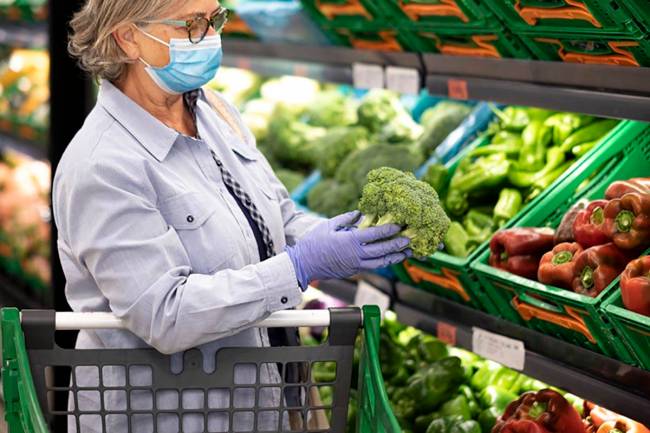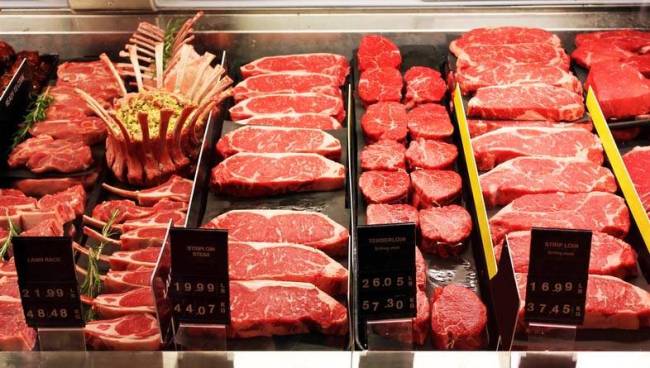Do you make any of these costly mistakes when grocery shopping?
If you want to save money on your food expenses, you’re better off preparing meals at home rather than dining out. But even if you’re buying most of your food at the grocery store, there’s a good chance you’re still spending more than necessary. That’s because you’re probably making mistakes while shopping at the supermarket. Find out which errors you’re making if you want to save more money on groceries.
Find out: 22 side gigs that can make you richer than a full-time job
Shopping on the wrong day
Cut grocery costs by simply shopping on the right day of the week. “We all get into a routine and often hit up our stores around the same time weekly,” said Tracie Fobes of Penny Pinchin’ Mom. “Make sure that you are shopping at the time when you can be certain to get every deal the store offers.”
For example, Fobes said her local supermarket runs a weekly ad from Wednesday to Tuesday. “Those items are all on sale for seven days,” Fobes said. “They also always offer a shorter sale period during that same time. It almost always encompasses a Friday and Saturday. By shopping on Friday, I am sure to not only have the opportunity to get the current weekly sale prices, but also those short-lived sale prices at the same time.”
Read more: $1,400 stimulus checks are still coming – but who’s eligible to get one?
Shopping without a list
Heading to the supermarket without a grocery list is a recipe for overspending. That’s because you’ll likely end up buying things you don’t really need and forgetting things you do need. This will force you to make extra trips to the store, which will cost you time and money.
“People waste a ton of money when they don’t write out a list of what they need before heading into the store,” said Kelly Anne Smith, former writer and email content specialist at The Penny Hoarder. “Not having a plan before shopping is one of the quickest ways to blow your entire grocery budget.”
Make money: 5 unexpected work-from-home jobs you can do right now

Shopping without a plan
Plan out your meals for the entire week — and check your pantry, fridge and freezer — before you head out to the grocery store so you can avoid making several trips to the supermarket during the week and blowing your budget.
“This plan has the added bonus of saving you more money by not dining out,” Fobes said. “Let’s face it, when you don’t have something on hand to make for dinner, it is easy to just go out to eat.”
If a family dines out one additional time a week due to not having a menu plan, the meal can easily run $25 or more, Fobes said. That can add up to $1,300 a year.
Making impulse buys
Another benefit of shopping with a list is that it can help you avoid making impulse buys. “Impulse buying is the biggest mistake,” said Stephanie Nelson of Coupon Mom. “Buying appealing but perhaps full-priced items that you don’t need is the most expensive mistake shoppers make.”
Learn the immediate things you can do to resist an impulse buy. The key is to actually stick to your list. Check items in your cart against your list before you leave the store to make sure you haven’t added too many things you weren’t originally planning to buy.
Ignoring weekly ads
It’s easy to just walk by the stack of weekly sales circulars as you enter the grocery store. But this weekly ad flyer could be the key to growing your savings.
“Pick up the store ad when you walk in the front door of the store,” Nelson said. “Even if you haven’t made a detailed list, you’ll see what the rock-bottom deals are on the front page.” Supermarkets also post weekly ads on their websites, so you can plan your shopping list based on the best deals.
Overlooking easy deals
Not only will the weekly ad show you what’s on sale, but it will also feature special promotions. For example, your grocery store might run a promotion that gives you a free gallon of milk when you buy three boxes of sale-priced cereal, Nelson said.
“If you don’t know about the promotion, you might get three boxes without grabbing the free item,” Nelson said. If you don’t check the weekly ad for these easy-to-score deals, you’ll likely miss out on savings.
Shopping for a recipe
On average, only two out of 10 items in a recipe will be on sale in a given week, said Teri Gault, author of “Shop Smart, Save More.” If your shopping list is based on ingredients you need for a recipe, you’ll end up overpaying for about 80% of what goes in your cart.
“Instead, choose recipes according to what you already have and what’s on sale,” Gault said. So, if chicken is on sale but beef isn’t, opt for chicken recipes. Plan your menu around the biggest pictures on the front page of your supermarket’s weekly sales ad, Gault added.
Buying when you run out of something
There’s a good chance you’ll pay more than necessary if you wait until you run out of items to replenish your supply. When you run out of something, there’s a good chance that what you need will not be on sale, Gault said.
Grocery sales run in cycles, so you’ll likely find most items you need are discounted at some point each month. “By stocking up on sale items that you regularly use, you should rarely be forced to pay full price,” she said. According to Gault, the best sales are when items are marked down at least 50%.
Be aware: 40 supermarket buys that are a waste of money

Shopping the first produce display
You’ll often find marked-down produce in a big display as you enter the produce section, Gault said. However, this might not be the best produce deal in the store or the one you saw in the weekly ad.
“Be sure to check the price against the ad, as often the featured sale is not as easy to find,” she said. “You might find your deal in the middle or back of the produce section.”
Buying the same things every week
It’s easy to fall into the habit of buying the same things at the supermarket every week. But you’ll end up paying more if you’re putting items in your cart regardless of price.
“Vary your diet and preferences by trying the sale-priced options,” Nelson said. “For example, get sale-priced broccoli instead of full-priced asparagus, and reverse that when the sales switch. That principle applies in every department of the store.”
Not signing up for rewards
Most supermarkets have rewards programs that are free to join and allow members who swipe their rewards cards at checkout to get discounts on select items.
Plus, some supermarkets’ rewards programs let members earn points for discounts at the gas pump. For example, at Safeway you can get 10 cents off per gallon for every $100 spent on groceries. Taking advantage of these special discounts and rewards can add up to major savings.
Assuming you need to swipe your rewards card
You don’t have to forgo discounts if you leave your supermarket rewards card at home. You can typically enter the phone number linked to your account to claim your rewards membership savings.
When you’re prompted to swipe your rewards card at the checkout, look for the option to enter your alternate ID — which is usually your phone number. Don’t give up free money — and make sure your savings get applied.
Thinking you need to spend time clipping coupons
You don’t have to scour the Sunday paper to find grocery coupons. Most supermarket chains offer digital coupons and personalized deals, Gault said.
You can link your rewards card to a store’s website and click on the digital coupons that you want to add to your card. Your discount will be taken at checkout — you won’t need any paper coupons.
Not stacking coupons
Combining a manufacturer’s offer with a store offer is an overlooked way to save a lot of money. You’ll need to invest a little more time than you would simply looking for your supermarket’s digital coupons to score savings, though.
You can find printable manufacturers’ coupons to stack with grocery store coupons or sales at sites like Coupons.com, Coupon Mom and SavingsAngel.
Not getting the ‘peelie’ coupon
Some products have coupons attached to them that you peel off and use for a discount. Often, the “peelie” has already been removed from products at the front of the shelf, said Gault. “Just reaching a little further back for one that still has a peelie can save you money right now,” she said.
Not using your supermarket’s app
Most grocery stores have free apps you can use to score supermarket savings on the go. The app is an easy way to keep track of digital coupons while you’re in the store — especially if you didn’t do it at home.
Sometimes, stores offer personalized coupons on their apps based on your shopping history. For example, you might get an offer to save 67% on a particular produce item that’s not on sale otherwise, Gault said. “Some digital coupons are for free groceries, possibly something you were planning to buy anyway,” she said.
Shopping without rebate apps
“There are multiple cash-back apps to help stretch your dollar at the grocery store,” Smith said. “I personally love Ibotta because it has such a wide range of products with rebates.”
You can download the free app, search for items you want to buy to see if rebates are available and then unlock the rebates by performing simple tasks — such as watching a short video — she said. After you buy the items, scan the barcodes and your receipt. Once you’ve earned at least $20, you can get your cash through PayPal or gift cards.
“By not utilizing these cash-back programs, you’re wasting an opportunity to spend anywhere from 5 cents to $2 less on everyday items,” Smith said.
Not using a rewards credit card
You can get even more cash back on grocery purchases with a rewards credit card. For example, you can get 6% cash back on U.S. supermarket purchases of up to $6,000 per year — and 1% after that — with the American Express® Blue Cash Preferred card. Terms and restrictions apply to benefits and offers. Many credit cards offer rewards for grocery store purchases.
Not using discounted gift cards
Another way to score easy discounts on groceries is to use discounted gift cards. You can find supermarket gift cards selling for less than face value online. You can use a site such as Gift Card Granny to find which gift card reseller is offering the best discount on the card you want.
The savings might not always be dramatic, but it’s a relatively easy way to save money at the supermarket checkout.
More shopping advice: The worst things to buy at Walmart and Target

Assuming bigger is always cheaper
Buying items in bulk can help you save money. But you shouldn’t always assume that the biggest package is the best deal, Nelson said. For example, you might find that the sale-priced, smaller size has a lower unit cost than the largest size. Check the unit price before you buy it.
Buying more than you need
Buying the biggest size — such as a 10-pound bag of potatoes instead of the 5-pound bag — can also backfire if you can’t consume all of it before it goes bad. “The average household throws away 20% to 40% of perishable items,” said Nelson.
Regardless of whether you got those items at a discount, you’re not saving money if you’re not eating them. “It’s better to run out of an item than to throw away unused food,” she said.
Being loyal to certain brands
“We get so set in our ways of sticking with the same brands that we often will pay premium prices just to buy them,” Fobes said. “What many people do not realize is that most store brands are the name brands with a different label.” The name brands can cost as much as 25% more than the store brand, she added.
So if you want to save money at the supermarket, ditch your brand loyalty. “Without even using coupons, you can cut 25% off your grocery bill by choosing the sale-priced brand of your regular items instead of being strictly loyal to one brand,” Nelson said.
Underbuying sale items
Don’t think of a sale as a chance to get an item you regularly buy at a discount. Think of it as an opportunity to stock up and save big.
For example, if you use chicken every week and it’s 50% off, you should buy enough to stock the freezer for two or three weeks until it’s 50% off again, Nelson said. “This simple strategy can save a family of four a few hundred dollars a year compared with paying the going price each week,” she said.
Shopping hungry
“When you are hungry and there is nothing to fix at home because you did not plan properly, you will run to the store,” Fobes said. “You will buy items you normally would not because your hunger is in control of what is being added to your shopping cart.”
Even if you go on a planned shopping trip, you could end up making more impulse buys if you shop while you’re hungry. “You can often find you save 10% to 20% if you just shop when you are not hungry,” she said.

Paying for meat processing
“You reach for that package of cubed steak and pay 20% more than you need to,” Gault said. Instead, buy meat that hasn’t been cut or processed and ask the butcher at the grocery store to cut or tenderize it for you. Most full-service supermarket butchers will do this for no charge, Gault said.
You also can save money by purchasing whole chickens rather than pieces. “The cheapest chicken is the whole chicken, and it only takes a few minutes to cut into pieces,” Gault said.
Buying packaged dinner mixes
Packaged dinner mixes might be convenient, but you’ll pay a premium for that convenience. For example, the typical price of a packaged pasta skillet dinner is $2-$3 for a single box.
Instead, make cheap pasta meals yourself. Start with a 1-pound box of pasta, which makes eight servings and costs as little as $1.
Buying bagged seasonal fruit
Buying produce when it’s in season is a good way to get the best price on fruits and vegetables. But Gault said you should avoid buying seasonal fruit by the bag rather than by the pound.
For example, when apples are on sale for 99 cents a pound, a bag of the same type of apples will usually cost more, she said. The price of grapefruit, oranges, avocados and other fruits in season will also cost less by the pound than by the bag. The same applies to sales on individual produce, like avocados, which are usually cheaper by the pound than the bag.
Always opting for fresh produce
During the winter, buying fresh produce gets more expensive because so few fruits and vegetables are in season. So, it’s the perfect time to turn to frozen options, which are less expensive.
Not only can you save money with frozen produce, but you might also get better quality fruits and vegetables. Frozen produce is picked when ripe and then flash-frozen — not picked ahead of time to allow for shipping time — so it can contain more of the vital nutrients you’re looking for.
Underbuying things you regularly eat
Don’t waste money buying small packages of products you eat regularly. For example, perhaps you grab a 16-ounce bottle of soda near the checkout because it’s cold instead of a 2-liter bottle of soda that’s room temperature. You pay about the same price and get 75% less.
This applies to a variety of products. Although you shouldn’t buy more than you can consume or always assume that the biggest package is the best deal, you can save by buying more if you can freeze or store what you’re not going to use immediately. And you might get a better deal by purchasing, say, a big package of chips and parceling them out for school lunches rather than packing small, individual packages.
Comparing prices without noticing sizes
When you compare prices, you should also compare the amount you’re getting for the price. For example, sometimes the name-brand bottle of juice contains 59 ounces and the store brand contains 64 ounces, Gault said. Sometimes a “pound” of bacon is only 12 ounces instead of a pound.
“So what you think looks like a better price has 25% less bacon,” she said.
Paying for the stock person’s mistake
It happens to all of us: You think you’re reaching for what’s on sale, but you end up with higher-priced items because someone made a mistake stocking the shelf.
“Often, [products] look similar, which is how they got misplaced in the first place,” Gault said. “Either way, you just paid about twice as much as you thought you would.” Carefully check the name and size of the sale item to make sure it matches the item you place in your cart.
Buying certain end cap items
“Some of the best deals are on the end cap — a shelf at the end of an aisle. But they are often paired with other items that are not the best deal,” Gault said.
For example, you might see an end cap for stuffing, creamed soup and canned vegetables. You might find a different brand of creamed soup down the aisle for much less, though, she said.
Buying items you can get for less elsewhere
It might be convenient to buy health and beauty products while you’re doing your grocery shopping. But you’ll pay a lot less if you buy these items at a national drugstore chain. Pharmacies run sales, coupons and other offers weekly, and they can often be stacked for huge savings.
Failing to check your receipt for errors
Before you leave the store, check your receipt, Gault said. Make sure you got all the sale prices, instant rebates and coupon discounts you deserve. “Sometimes — inadvertently — deals are missing that could cost you a few dollars, or more,” she said.
Failing to check your receipt for savings
Another reason to check your receipts and hang onto them is that they often offer opportunities to save the next time you shop.
“Throwing away receipts or shoving them into the bottom of your bag is almost as bad as throwing away a $10 bill,” Smith said. “Sometimes there are survey codes at the bottom with incentives for filling them out, like coupons for your next grocery run.”
Only shopping at eye level
Most grocery stores place the most expensive items at eye level since you’ll be drawn to them first. Be sure to scan the upper and lower shelves to find better deals on the items you need.
Paying more than you need to for chicken
If you opt not to buy a whole chicken, make sure you aren’t overpaying for the parts. Chicken breasts are often more expensive than chicken thighs — even though thighs are just as nutritious.
Shopping more than once a week
The more often you shop, the more often you open the door for impulse buys. If you find that you’re heading to the grocery store more than once a week, this is probably a sign that you aren’t doing a good job at planning out your trips.
Filling up your cart
Supermarkets provide you with oversized carts so that you don’t realize how much you are putting into it. If it’s feasible, shop with a basket. If you need to use a cart and it looks full when you’re heading to the checkout line, take a moment to ask yourself if there’s anything you can put back on the shelf.

Not taking advantage of the in-store pickup option
Several grocery chains — including Kroger — allow you to place an online order that you can pick up at the store for free. Doing this eliminates impulse buys altogether, allows you to shop directly through the weekly ad, seamlessly add digital coupons to your order and see exactly what your haul will cost before you check out.
Buying precut vegetable and fruits
Just as you’ll pay more for steak that’s precubed, you’ll also pay a premium for vegetables and fruits that are already prepeeled, sliced and diced. Resist the temptation to take the easy route and you’ll be rewarded with more money in your pocket.
Not bringing your own bags
Many cities and states now charge you a fee if you do not bring your own reusable bags. While a 10-cent fee might seem minor, if you use five bags on your average haul, that adds up to an extra $2 every month.
More From GOBankingRates
How long $1 million in savings will last in every state
27 ugly truths about retirement
Gabrielle Olya contributed to the reporting for this article.
This article originally appeared on GOBankingRates.com: Costly mistakes people make while grocery shopping


















